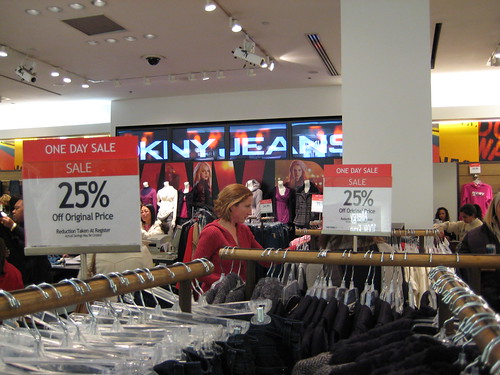CC image courtesy of Phillie Casablanca from Flickr.
A recent Washington Post article describes how people have been increasingly empowered to haggle at stories like Macy's. Consumer not only are looking to stretch their dollars further in the recession but also can make credible threats to brick and mortar stores that they will shop elsewhere. This is exceptionally painful for places like shoe stores, where customers can make sure that the product fits and feels comfortable before threatening to buy it online.
The reporter's narrative begins:
The price tag on the smooth pair of Cole Haan loafers at Macy's said $148. I considered that a fair opening bid. Standing across from the salesman and the cash register, I said, "Can you knock off 25 percent?"
The salesman said, "Can't do it." But I pressed on: "I'll get them on the Internet or at one of your competitors, so let's just do this here."
Salesman: "Geez. You're like the second person who has tried to do this today."
We stared at the shoe box. I liked what was inside. The loafers fit well, but they would feel even more comfortable with a discount.
Macy's blinked first. "Ten percent off," the salesman said. "That's the best I can do." I sensed an advantage and counteroffered: "Let's do 20 percent." I then sensed annoyance and settled for the 10 percent.To understand Macy's situation, it's helpful to think in marginal terms. Macy's has a lot of costs that are more or less fixed no matter how many items it sells: its advertising budget, the rent it pays for its stores, and its employee salaries. But each item that Macy's sells also has a marginal cost. For the above-mentioned pair of shoes, maybe Macy's paid $110 to the wholesaler. Any price it sells the shoes for above $110 represents a profit on the margin.
It tries to pad this profit margin to offset some of the fixed costs, of course. But on each individual item, whenever the store is making more money than it paid, it's a win. On each item, refusing a $1 profit would be foolish.
I've cited this post before, but it's another great example of marginal analysis. A budding economist only has a dollar in his wallet but sees that sending a fax costs $2. He convinces the store manager that not letting him send a fax for a dollar would be foolish, as even half the list price would net the store at least a 50-cent profit. The store manager agreed.
Going even further, perhaps it's in a store's interest to accept a loss on the margin in certain circumstances. Taking a one-time loss to appease a flighty customer will be worth it if the customer remains loyal, though it's difficult to determine when these discounts will have the desired effect.
Additionally, if an item has not sold very well, it is in the store's interest to get rid of it for whatever it can get, even if the price is well below what the store paid for it. Liquidation sales also fall under this same concept: it is cheaper to get rid of the items at steep discounts in a store that is set to close than it is to pack and ship all of the items elsewhere.

1 comment:
Good analysis. Rosenwald's article has generated tons of buzz--mostly by the economically uneducated. Also note that once a retailer has made a profit on, say, 800 items in a lot of 1000, then the remaining 200 items on the shelf may be ALL profit with no margin left. So, there is no reason NOT to "blow 'em out" at any price!
Post a Comment